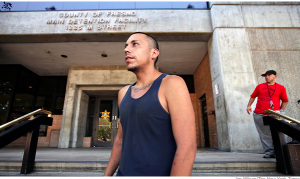The following article is reprinted from a February posting, as it speaks to the dilemma that California criminal justice policy makers.
According to the Sacramento Bee, “Gov. Jerry Brown had his “Mission Accomplished” moment…… He believes “victory should be declared” in the state’s prison overcrowding crisis” He was also quoted as saying “California’s prison health care system is now a model for the nation,” and that any further reduction in state prisoners would endanger the public’s safety.
Clearly the Governor has much to be proud of. He had pushed through the legislature, AB109, a bill that reduced prison populations by about 50,000 prisoners in a year, and fought successfully for Proposition 30, making billions of dollars available to counties impacted by Brown’s transitioning of responsibility for non-violent, non-serious, and non-sex-offenders to the counties. Still, what has been accomplished is the first part, the easy part of prison reform, More complicated and critical reforms have not begun to be addressed.
State prisons still house offenders who could do better in their own communities, even if it means spending additional time in county jail. AB109 was intended to encourage alternatives to incarceration, but relatively few counties are accepting that challenge, Instead most are expanding and/or building new jail facilities. Somehow, we must encourage counties to spend more of their Proposition 30 money on alternatives to prison rather than jail substitutes for prison. One obvious reform would be to encourage judges to sentence AB109 offenders to spit sentences (offenders who must be housed in jail, even though the offense is defined as a prison offense), so that the court could supervise their jail conduct and rehabilitation in the community. More than 80% of AB109 offenders sentenced to jail receive a jail sentence that cannot be reduced or transferred to community supervision.
While Governor Brown’s prison reform limits those sent to prison to more serious offenders, it ignores the doubling of prison sentences for serious offenders over the past twenty years. Why assume that the legislature’s response to sensational crime with ever increasing penalties is rational or justified. Why assume that the labyrinth of sentencing law and enhancements make sense or are necessary or appropriate.
Then there are the obvious reforms that almost everyone supports, but for some reason are almost never implemented. Drug, alcohol and mental health treatment, education, and job training while the offender is in custody, is almost universally supported by the public. Half-Way Houses or similar Institutions, that allow the offender to transition to the outside, while continuing under custodial or other substantial supervision are also favored by most. Finally, continued oversight of the offender while in the community, under the care and supervision of the court and supervisory agencies (through AB109 split sentencing or reentry courts) is a necessity for most successful prisoner rehabilitation.
It’s easy to see that the governor has done well in beginning the prison reform process in California. Stopping now, without continuing and expanding its scope, providing resources, assistance, and supervision to those coming out of custody, will surely set the incarcerated up for continued failure and and a return to custody.




